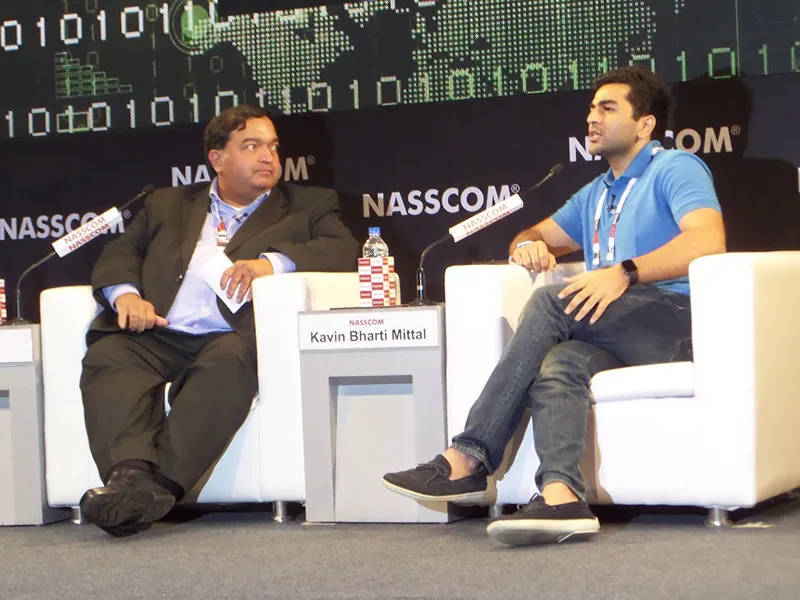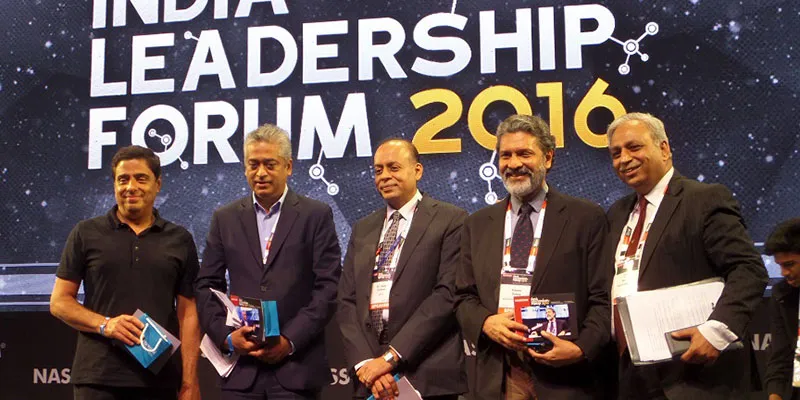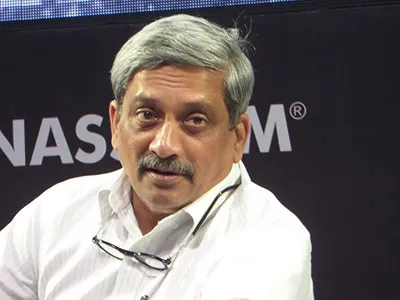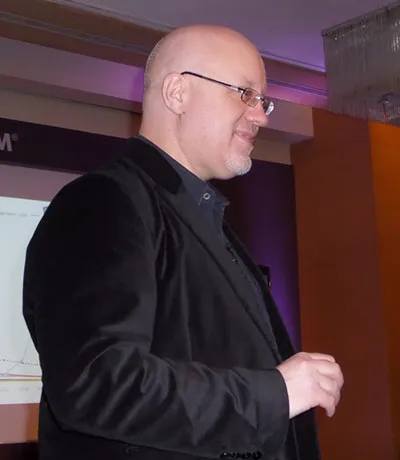Set lofty goals but validate them in real time: startup tips from Leadership Forum 2016
The key success factors for startups in India are to be able to think big – but also test often and pivot as needed, according to a range of speakers at NASSCOM’s India Leadership Forum 2016, held this week in Mumbai.
Here are my six key clusters of takeaways from this forum, in terms of the startup ecosystem, tech trends, innovator DNA and government partnerships. See also my earlier article: ‘Learn, unlearn, re-learn: innovation tips from India Leadership Forum 2016.’

Think big, start small, test often, scale fast
“Place big bets, but validate them 24X7,” advised Kavin Bharti Mittal, Founder and CEO of Hike. The messaging app crossed the 100 million user mark in December 2015. Continuous and lean innovation has been the key to the success of the startup over the last three years.
“We have built a range of startups within our startup – they work as empowered ‘squads,’ and can spot opportunities and create features in an agile manner,” said Kavin. Roles in the company change very often as well.
“The best people don’t have to be policed, they have to be unleashed,” he said. There are more downs than ups in entrepreneurship, many founders will be dismissed as crazy, and many startups will fail, he cautioned aspiring founders in the audience.
Talent attraction and retention can be stumbling blocks for growth-stage startups. The best way to drive great work is through recognition, promotion, autonomy, and training - not just increased pay, advised Kevin Ames, CEO of OC Tanner.
Thinking big applies to Indian policymakers and industry as well. “Set lofty goals, and achieve at least 80 per cent of them. India does not set lofty goals,” said Ronnie Screwvala, author of ‘Dream with your eyes open’ (see my book review).

Think big but also think local
There is much hype about rapid smartphone adoption in India, but that accounts for only 150 million users in India who are mostly using it in sachet pre-paid mode, cautioned Kavin Mittal. This also needs to be opened up to Indian languages (see YourStory coverage of Mobile India 2016).
Hike messaging is available in eight Indian languages, and the micro-news content is available in Hindi and English. The articles, less than 60 words in length, will also be published in another seven languages by the end of the year, said Kavin. He predicted that apps in India will become obsolete like CDs for data, and messaging will take over.
India’s spotty mobile coverage also calls for creative models like ‘offline Internet,’ said Rajan Anandan, VP of Google India and Southeast Asia. Indian consumers want lower price points but will not settle for poor quality, he said. Regulators in China and Vietnam have set up infrastructure pricing which is not overly burdensome for providers in the early stages.
Net Neutrality
In addition to business matters, startups need to be actively involved in larger issues which affect them, such as Internet governance. Net Neutrality is key to ensure that the Internet is a level playing field, which will be important for India’s democracy as well as the next wave of startups. It should not be partially subsidised as if it is a ‘Third World charity scheme’ by some Western company, said Vijay Shekhar Sharma, Founder of PaytTM. The ambitious initiatives such as Make In India and Startup India should be accompanied by ‘Connected India,’ he suggested.

In that regard, the TRAI ruling against differential pricing is seen as a welcome move. Net Neutrality should ‘stay forever’ in India, said Rajan Anandan. Google’s approach in India has been to propose free WiFi in 500 railway stations rather than sponsor restricted access to the Net via mobile operators.
Government role
The government’s role is to make it easy for startups and innovators to flourish, and provide high-quality digital and physical infrastructure. Ambitious initiatives like the National Optical Fibre Network have yet to fully scale up, and the physical infrastructure in most Indian cities leaves a lot to be desired.
The government’s Community Services Centres initiative is delivering digital services to rural areas via local entrepreneurs, said Ajay Kumar, Additional Secretary, Department of Electronics and IT. Other initiatives are happening at the state level as well.
Indian states should also be competing in terms of which one has the best digital infrastructure, tariffs, penetration and innovators, said Vijay Shekhar Sharma. Internet access should be promoted in post offices and other community locations as well. Rather than giving away free TVs, politicians should be giving away free smartphones, he joked.
The defense sector in India lags way behind others in terms of funding or partnering for the creation of digital innovations, such as the Internet and GPS (US) or cyber-security products (Israel). However, steps in this direction are beginning, as the military is seeking more ties with India’s IT sector, said Defense Minister Manohar Parrikar. The audience urged him to reach out more to Indian companies developing drones, IoT, sensor/scanner networks and cyber-security solutions.

Corporates can also work with government and startups through CSR initiatives. Rajeev Dubey, HR Head at Mahindra & Mahindra, said the company had a range of CSR initiatives in digital health, education and skilling (see also YourStory coverage of NASSCOM’s CSR Leadership Conference).
Think ecosystem
Success will favour those innovators who think not just in terms of their own organisation but the whole ecosystem (see also my book review of ‘Wide Lens Innovation’). Leadership of the future will be in innovation, operational excellence, customer intimacy, and creating of the best products and services, said Joe Weinman, author of ‘Cloudonomics.’ Successful innovators are not creating separate digital and physical channels but fusing them with the broader ecosystem.
“Success is in digital-physical fusion. But not handled properly, it leads to confusion,” cautioned Weinman. IoT intelligence will come not just from ‘embedded smarts’ but also ‘connected smarts’ across the ecosystem and even between ecosystems.
“Traditional lab-led innovation will be augmented and accelerated by cloud-based innovation,” said Weinman, pointing to crowdfunding and crowdsourcing as rising trends.

Think long term
While it is tempting to think short-term and quickly ride trends and fads, innovators should keep an eye on long-term changes as well. “The major disruption in the future will be personalisation of artificial intelligence,” said Brett King, CEO and Founder of Moven Bank. By 2025-2030, there will be more robotic devices on the planet than humans, marking the dawn of the Augmented Age, he predicted.
Robotics will disrupt global sourcing in the manufacturing sector. Manufacturing will increase with robotics – but not necessarily with new jobs, which will be a challenge for large corporates and government regulators.
Brett painted some fascinating scenarios, such as embedded eye lenses with three times 20X20 vision, and futuristic decisions which humans will have to make in terms of how much of a cyborg they want to become.
To survive in an age of such change, the education sector will have to absorb a larger role for apprenticeship, hackathons and online learning to connect more in real-time to the real world. Countries to watch are Japan, which is the most industrially advanced to create robots and the most culturally advanced to accept them in social life.

“Technology is the new super-natural force,” Brett said. Artificial intelligence will create better machines and better humans, he explained, classifying AI into three types: machine intelligence, artificial general intelligence, and super/hyper intelligence.
Growth fields for innovators to watch are data science, experience design, meta-materials, and behaviourial psychology, summed up Brett.







